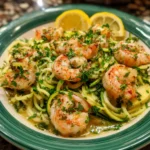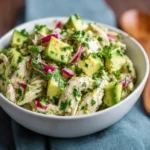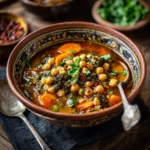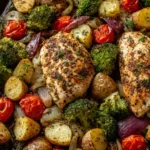One-Pot Lemon Chicken Orzo: A Zesty, Comforting Meal Made Easy
If you’re craving a dish that combines the rich comfort of pasta with the bright freshness of citrus, look no further than One-Pot Lemon Chicken Orzo. This Mediterranean-inspired recipe brings together tender chicken, creamy orzo, and a tangy lemon sauce—all cooked in a single pot for minimal cleanup and maximum flavor. Whether you’re cooking for your family on a busy weeknight or hosting a casual dinner party, this one-pot wonder delivers elegance without effort. With its vibrant taste and satisfying texture, it’s no surprise that One-Pot Lemon Chicken Orzo has become a staple in modern home kitchens around the world.
The History Behind the Dish
The roots of One-Pot Lemon Chicken Orzo trace back to the culinary traditions of the Mediterranean, particularly Greece and Southern Italy, where simplicity, fresh ingredients, and bold flavors define the cuisine. Orzo, a rice-shaped pasta, has been a pantry staple in these regions for centuries, often used in soups, salads, and baked dishes. Meanwhile, lemon is a hallmark of Greek cooking—used liberally to brighten meats, seafood, and vegetables. Dishes like lemon-herb roasted chicken and avgolemono (a lemon-egg soup) showcase the region’s love for citrus-infused meals.
While traditional recipes often required multiple pots and steps, modern adaptations have streamlined the process. The concept of “one-pot” meals gained popularity in the 21st century as home cooks sought efficient, flavorful, and less messy ways to prepare dinner. Combining chicken, orzo, broth, and lemon into a single skillet or Dutch oven not only saves time but also allows the ingredients to meld beautifully. Today’s version of One-Pot Lemon Chicken Orzo is a delicious fusion of rustic heritage and contemporary convenience.
Ingredients Breakdown: What Makes It Sing?
The magic of this dish lies in its balanced blend of high-quality, accessible ingredients. Each component plays a vital role in building layers of flavor and texture:
- Chicken Breast or Thighs: Boneless, skin-on or skinless chicken provides lean protein and becomes incredibly tender when simmered in broth. Thighs offer more moisture and richness, while breasts are lighter and cook quickly.
- Orzo Pasta: This small, oval-shaped pasta absorbs flavors like a sponge and releases starch to thicken the sauce naturally, giving the dish a creamy consistency without dairy.
- Lemons: Fresh lemons contribute both zest and juice. The zest adds aromatic oils, while the juice brings acidity that cuts through richness and lifts the entire dish.
- Garlic and Shallots/Onions: These aromatics form the flavor base, sautéed until fragrant to create depth before adding other ingredients.
- Chicken Broth: A good-quality broth enhances umami and acts as the cooking liquid for the orzo, infusing every grain with savory goodness.
- Olive Oil: Used for searing the chicken and sautéing vegetables, extra virgin olive oil adds fruitiness and richness.
- Dry White Wine (optional): Adds complexity and brightness. Choose something crisp like Pinot Grigio or Sauvignon Blanc.
- Fresh Herbs: Parsley, dill, or oregano finish the dish with a pop of freshness and color. Flat-leaf parsley is most common.
- Salt and Pepper: Essential for seasoning each layer of the dish.
- Optional Add-Ins: Spinach, artichokes, sun-dried tomatoes, feta cheese, or capers can elevate the dish with additional textures and flavors.
Step-by-Step Recipe
Follow this detailed guide to make a perfect One-Pot Lemon Chicken Orzo every time. Total time: approximately 40–45 minutes.
- Prep Ingredients: Dice 1 small shallot or onion. Mince 3–4 garlic cloves. Cut 1–1.5 lbs (450–680g) boneless chicken breast or thighs into 1-inch pieces. Zest and juice 1–2 large lemons (you’ll need about ⅓ cup juice). Measure out 1 cup orzo, 2 cups chicken broth, ½ cup white wine (optional), and chop ¼ cup fresh parsley.
- Sear the Chicken: Heat 2 tablespoons olive oil in a large, deep skillet or Dutch oven over medium-high heat. Season chicken with salt, pepper, and a pinch of dried oregano. Add chicken in a single layer and cook for 3–4 minutes per side until golden brown. Remove and set aside.
- Sauté Aromatics: In the same pan, add the diced shallot and cook for 3–4 minutes until softened. Stir in minced garlic and cook for 30 seconds until fragrant—do not let it burn.
- Add Orzo and Liquids: Stir in 1 cup orzo and toast for 1–2 minutes to enhance nuttiness. Pour in ½ cup white wine (if using) and let it bubble for 1 minute. Then add 2 cups chicken broth, ⅓ cup lemon juice, and lemon zest. Stir well.
- Simmer with Chicken: Return the seared chicken and any accumulated juices to the pot. Bring the mixture to a boil, then reduce heat to low. Cover and simmer for 12–15 minutes, stirring occasionally, until orzo is al dente and most of the liquid is absorbed.
- Finish the Dish: Remove from heat. Stir in 2 tablespoons butter or a splash of heavy cream for extra silkiness (optional). Taste and adjust seasoning with salt and pepper. Fold in fresh parsley and a handful of baby spinach (if using) until wilted.
- Serve: Garnish with extra lemon slices, chopped herbs, and crumbled feta cheese if desired. Serve hot, ideally with a crusty baguette or a simple arugula salad.
Pro Tips for the Best Results
- Don’t Overcook the Chicken: Since the chicken continues to cook during the simmering phase, sear it just enough to develop color. Over-browning now can lead to dry meat later.
- Toast the Orzo: Toasting the orzo in oil before adding liquids enhances its flavor and prevents mushiness.
- Use Fresh Lemon Juice: Bottled lemon juice lacks brightness and can taste flat. Always use freshly squeezed juice for optimal flavor.
- Control Liquid Levels: If the orzo isn’t fully cooked but the liquid is gone, add a splash of warm broth or water and continue cooking.
- Rest Before Serving: Let the dish sit off the heat for 5 minutes after cooking. This allows the orzo to absorb remaining moisture and results in a creamier texture.
- Avoid High Heat During Simmer: Keep the heat at a gentle simmer to prevent sticking or scorching on the bottom.
- Stir Gently: Stirring too much can break the orzo grains. Stir just enough to prevent sticking.
Variations and Customizations
This recipe is highly adaptable to suit different tastes, dietary needs, or what you have on hand:
- Creamy Version: Stir in ¼ cup grated Parmesan, cream cheese, or mascarpone at the end for a richer, velvety texture.
- Vegan/Vegetarian Option: Omit chicken and use mushrooms, chickpeas, or tofu. Swap chicken broth for vegetable broth.
- Gluten-Free: Replace orzo with gluten-free orzo (made from corn or rice) or small quinoa for a similar bite.
- Seafood Twist: Use shrimp or scallops instead of chicken. Add them in the last 5–7 minutes of cooking to avoid overcooking.
- Mediterranean Boost: Add kalamata olives, artichoke hearts, sun-dried tomatoes, and crumbled feta for a Greek-inspired medley.
- Spicy Kick: Add red pepper flakes or a dash of harissa paste for heat.
- Herb Variations: Try dill, mint, or thyme in place of parsley for a different aromatic profile.
- Baked Version: Transfer everything to an oven-safe dish, cover with foil, and bake at 375°F (190°C) for 20 minutes for a hands-off approach.
Health Considerations and Nutritional Value
One-Pot Lemon Chicken Orzo can be part of a balanced diet when prepared mindfully. Here’s a breakdown per serving (approx. 1.5 cups, serves 4):
- Calories: ~400–450 kcal
- Protein: ~30–35g (excellent source from chicken)
- Carbohydrates: ~45–50g (primarily from orzo; choose whole grain orzo for more fiber)
- Fat: ~12–15g (mostly heart-healthy monounsaturated fats from olive oil)
- Fiber: ~2–3g (can increase by adding vegetables)
- Vitamin C: High from lemon juice—supports immunity and iron absorption.
- B Vitamins: From chicken and orzo, aiding energy metabolism.
Healthy Swaps:
- Use skinless chicken breast to reduce saturated fat.
- Limit added butter or cream; rely on the natural creaminess of orzo starch.
- Increase volume and nutrients by adding leafy greens like spinach or kale.
- Reduce sodium by using low-sodium broth and controlling salt.
- Boost fiber by using whole grain orzo or a mix of orzo and lentils.
Who Should Be Cautious? Those monitoring carb intake (e.g., diabetics) should watch portion sizes. Individuals with gluten sensitivity must use certified gluten-free orzo.
Full Ingredient List
- 1–1.5 lbs (450–680g) boneless, skinless chicken breast or thighs, cubed
- 2 tbsp olive oil
- 1 small shallot or ½ small yellow onion, finely diced
- 3–4 garlic cloves, minced
- 1 cup orzo pasta
- ½ cup dry white wine (optional, substitute with broth)
- 2 cups low-sodium chicken broth
- Juice and zest of 1–2 large lemons (about ⅓ cup juice)
- Salt and freshly ground black pepper, to taste
- ½ tsp dried oregano (or 1 tsp fresh)
- 2 tbsp unsalted butter or 2 tbsp heavy cream (optional)
- ¼ cup chopped fresh parsley (plus extra for garnish)
- 1–2 cups fresh baby spinach (optional)
- Crumbled feta cheese, for serving (optional)
Detailed Directions
- Preheat & Prep: Gather all ingredients. Pat chicken dry with paper towels for better browning. Season with salt, pepper, and oregano.
- Sear Chicken: In a large, oven-safe skillet or Dutch oven, heat olive oil over medium-high heat. Add chicken in a single layer and cook 3–4 minutes per side until golden. Do not overcrowd. Transfer to a plate.
- Sauté Base: Reduce heat to medium. Add shallot and cook 3–4 minutes until soft. Add garlic and stir 30 seconds until fragrant.
- Toast Orzo: Stir in orzo and cook 1–2 minutes, stirring constantly, until lightly golden and nutty-smelling.
- Deglaze: Pour in white wine, scraping up browned bits from the bottom of the pan. Simmer 1 minute until reduced by half.
- Add Liquids: Stir in chicken broth, lemon juice, and zest. Bring to a boil.
- Combine & Simmer: Return chicken and juices to the pot. Reduce heat to low, cover, and simmer 12–15 minutes, stirring once or twice, until orzo is tender and liquid is mostly absorbed.
- Finish: Remove from heat. Stir in butter or cream (if using), parsley, and spinach. Cover and let stand 5 minutes. Adjust seasoning.
- Serve: Spoon into bowls. Top with extra parsley, lemon slices, and feta. Pair with a green salad or roasted vegetables.
Frequently Asked Questions (FAQ)
Can I make this ahead of time?
Yes, but note that orzo continues to absorb liquid. Reheat gently with a splash of broth or water to restore creaminess.
Can I freeze One-Pot Lemon Chicken Orzo?
It can be frozen for up to 2 months, though texture may soften slightly upon reheating. Thaw overnight in the fridge and reheat slowly on the stove.
Why is my orzo mushy?
Overcooking or too much liquid can cause mushiness. Stick to the recommended cook time and liquid ratio. Remember orzo thickens as it rests.
Can I use pre-cooked chicken?
Yes. Add shredded rotisserie or leftover cooked chicken at the end, just to heat through. Skip the searing step and reduce total cook time.
Is orzo the same as rice?
No. Orzo is a pasta shaped like rice, made from wheat. It has a higher protein and carb content than rice but offers a similar mouthfeel.
What can I serve with this dish?
It’s a complete meal, but pairs beautifully with a simple arugula salad with lemon vinaigrette, grilled asparagus, or roasted zucchini.
Can I use lemon extract instead of fresh lemon?
Not recommended. Extract is artificial and overpowering. Fresh lemon is essential for authentic flavor and balance.
How do I store leftovers?
Store in an airtight container in the refrigerator for up to 3–4 days. Reheat with a little broth to loosen the texture.
Summary
One-Pot Lemon Chicken Orzo is a vibrant, satisfying dish that marries tender chicken, al dente orzo, and a zesty lemon sauce in a single skillet—perfect for quick dinners with gourmet flair. Packed with flavor, easy to customize, and beloved by families and foodies alike, it’s a modern classic that belongs in every home cook’s repertoire.










